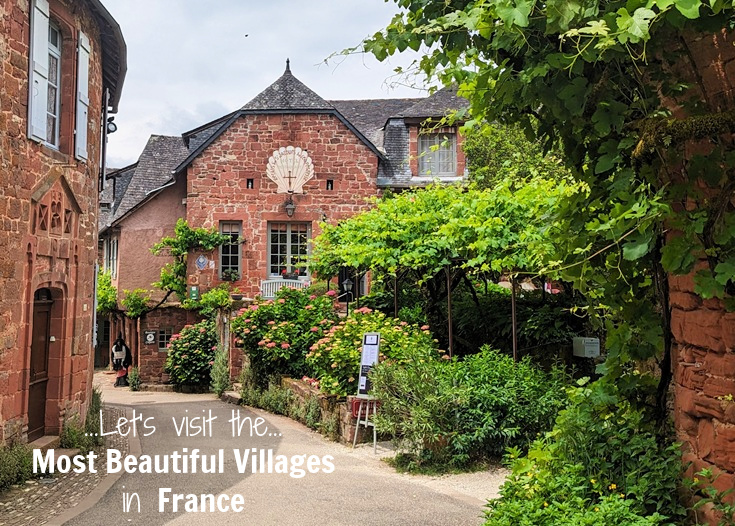
(Published June 2014, last updated September 2025)
One of the bonuses of venturing off the freeway and out into the French countryside is the likelihood that you’ll find yourself in one of the picturesque villages which have earned their classification among France’s ‘most beautiful’.
The association Plus Beaux Villages de France was formed by Charles Ceyrac, Mayor of Collonges-la-Rouge in 1981, at a time when many of the younger generation were leaving the small villages they grew up in to find work in larger towns.
Despite their historic monuments and charming back streets, many villages were unable to provide an economic foundation able to support the current and future generations.

Saint-Cirq-Lapopie (Chemin de Saint-Jacques, Célé variante)
Mayor Ceyrac’s dream was, that by preserving the beauty and cultural heritage of small villages, a steady stream of visitors would provide the demand for a flourishing hospitality industry, rekindle interest in the artisan crafts and once again breathe life into the towns.
His pledge was “to protect and promote the outstanding heritage of these exceptional villages and thereby provide them with an alternate to rural exodus”.
By March 1982, a further sixty-six mayors were on board and the association Plus Beaux Villages de France was officially formed.
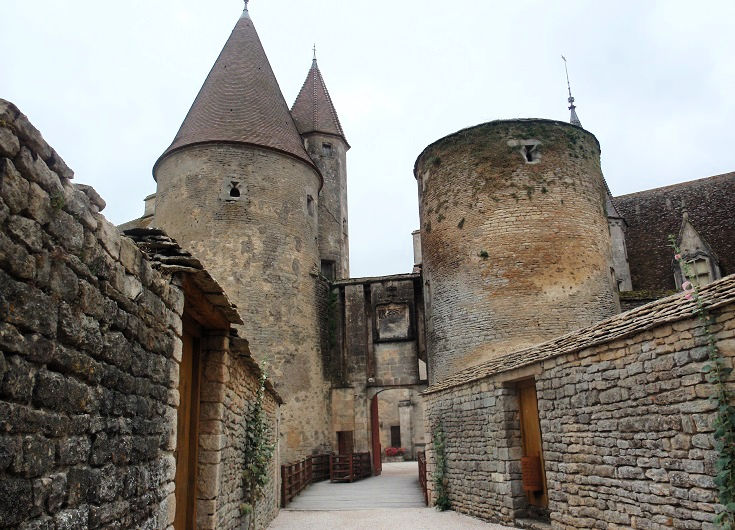
Châteauneuf-en-Auxois (Burgundy Canal)
To qualify as one of France’s most beautiful villages a strict set of criteria must be met. This includes a rural setting, a population of less than 2,000 and at least two historical monuments which the town commits to protecting and preserving.
Today (in 2025) the association has grown to include 184 villages, several of which are located on one of the many long-distance walks through France.
For me, the appeal of walking through France is to immerse myself in the spectacular scenery as I wander from one superb dinner to the next – so my suggested itineraries for each walk build in plenty of time to explore and soak up the atmosphere in each of these picturesque villages.
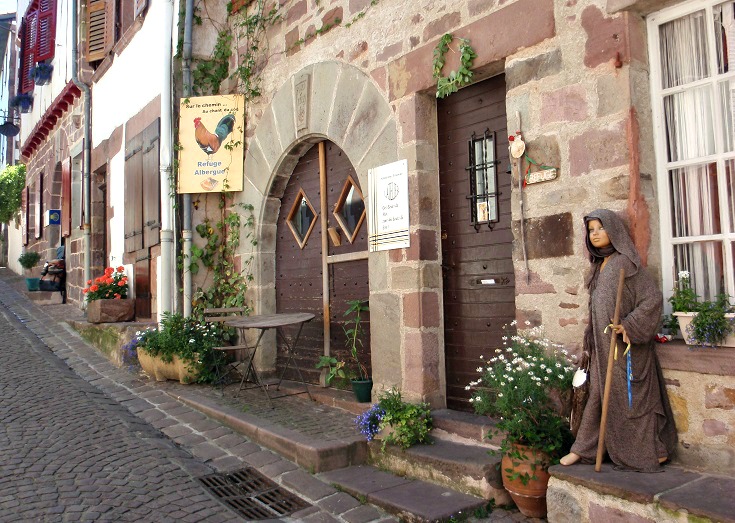
Saint-Jean-Pied-de-Port (Chemin de Saint-Jacques du-Puy)
Let’s start in Collonges-la-Rouge on the walk from Martel to Rocamadour, then continue on to discover 22 more of France’s ‘most beautiful villages’.
Most beautiful villages on the Martel to Rocamadour walk
The Lot, Corrèze and Dordogne regions of southern central France boast more than their fair share of France’s ‘most beautiful villages’. Nine of the prettiest can be visited on the 127-kilometre (80-mile) walk from Martel to Rocamadour.
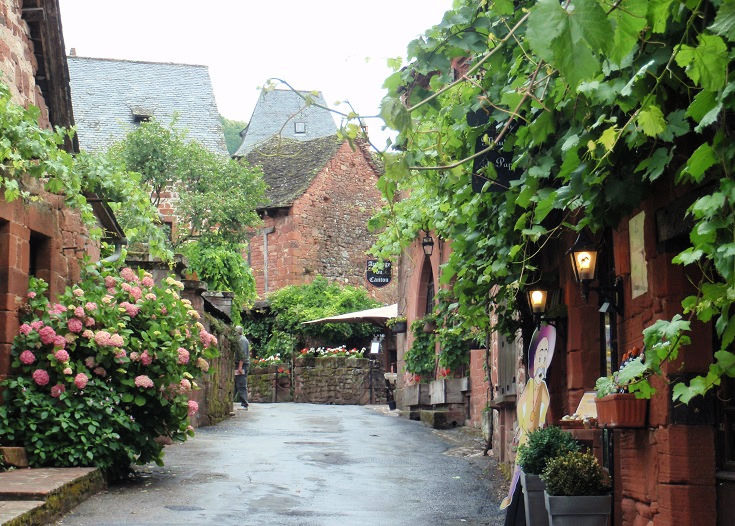
Collonges-la-Rouge (Martel to Rocamadour walk)
Collonges-la-Rouge
A definite contender for most beautiful of all ‘most beautiful villages’, Collonges-la-Rouge deserves a full afternoon (at least) for a leisurely visit. Filled with gorgeous dark red stone houses, turrets and towers, and overrun with flowering vines and shrubs, this is the quintessential vision of a fairy-tale village. Ask at the Tourist Office for a map of the village which provides a little history relating to the church, the Mermaid’s House and other historic buildings.
Collonges-la-Rouge is located 26.5 kilometres (16.6 miles) along the Martel to Rocamadour walk and is my recommended stop on the second day of walking.
Take a closer look around Collonges-la-Rouge and find a comprehensive list of accommodation and transport options.
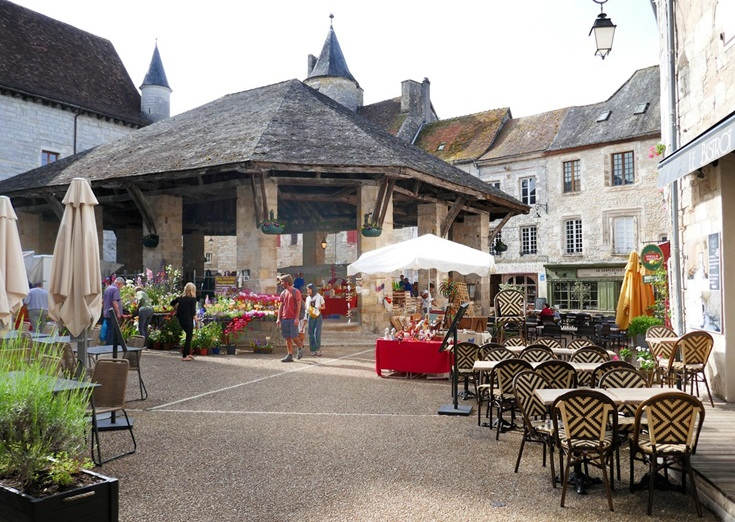
Martel (Martel to Rocamadour)
Martel
Founded in the eleventh century, Martel was once the capital and commercial hub of the Turenne region. In addition to ranking among France’s most beautiful villages, Martel is also classified as a Site Remarquable de Goût (goût meaning taste en français). Markets held here under the covered halle every Wednesday and Saturday morning offer world-class truffles, foie gras, cheeses and lamb—all from the surrounding area.
Martel is the starting point of the nine-day walk from Martel to Rocamadour.
Take a closer look around Martel and find a comprehensive list of accommodation and transport options.
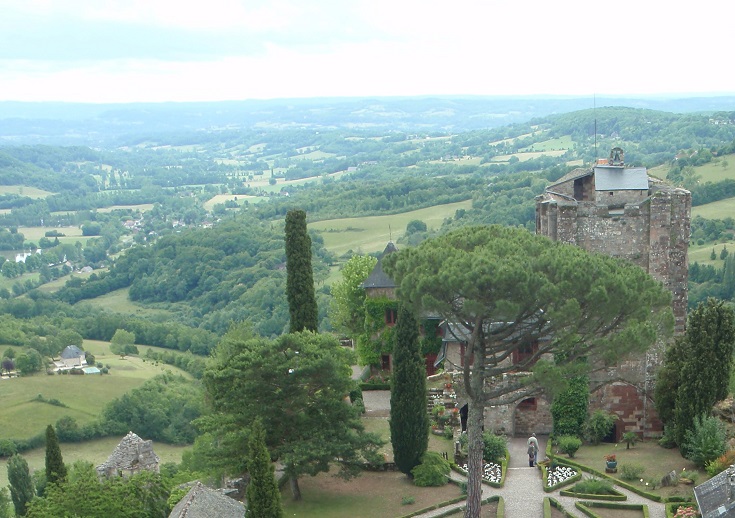
View from Tour César, Turenne (Martel to Rocamadour)
Turenne
A charming maze of narrow lanes, packed tight with old stone houses, lead uphill to the ruins of the tenth-century château. The space once occupied by the rooms of the château has been filled with a beautiful garden. All that remains of the château is the Guards’ Room which now houses a small museum and Tour César. Climb to the top for stunning views out over the countryside.
Turenne is located 18.2 kilometres (11.4 miles) along the Martel to Rocamadour walk and is my recommended stop on the first day of walking.
Take a closer look around Turenne and find a comprehensive list of accommodation and transport options.

Curemonte (Martel to Rocamadour)
Curemonte
Dominated by three châteaux (all privately owned and not open to the public), the village of Curemonte has a relaxed charm. The interior of the church retains its colourful wall and altar decorations and is well worth a visit. The French novelist Colette loved Curemonte so much that she spent many weeks here writing and mentions the village in one of her books – Journal à Rebours.
Curemonte is located 43.3 kilometres (27.1 miles) along the Martel to Rocamadour walk and is my recommended stop on the third day of walking.
Take a closer look around Curemonte and find a comprehensive list of accommodation and transport options.
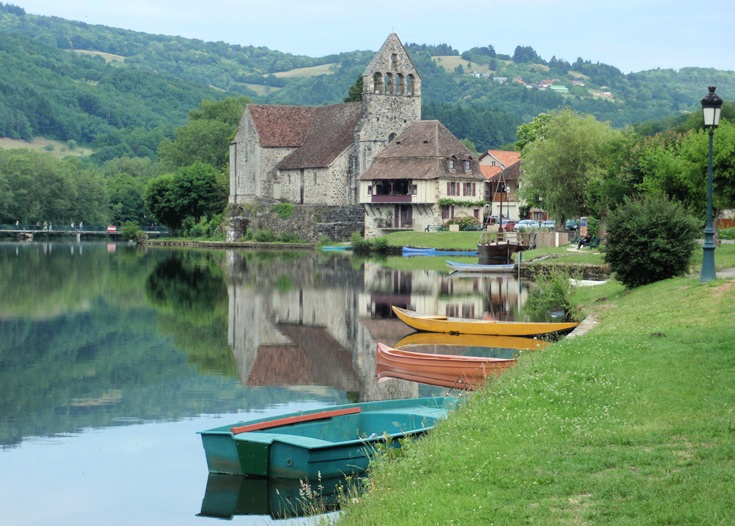
Beaulieu-sur-Dordogne (Martel to Rocamadour)
Beaulieu-sur-Dordogne
After the last few days of passing through small villages where pharmacies and supermarkets have been hard to find, Beaulieu-sur-Dordogne offers a welcome opportunity to stock up on bandaids and trail mix and to raid the ATM. The narrow streets wind through a sprawling town centre which surrounds the Benedictine abbey church dedicated to Saint-Pierre and leads down to banks of the river where the Chapelle des Pénitents is reflected in the waters.
Beaulieu-sur-Dordogne is located 56.1 kilometres (35.1 miles) along the Martel to Rocamadour walk and is my recommended stop on the fourth day of walking.

Place de la Fontaine, Autoire (Martel to Rocamadour)
Autoire
Established in Roman times, Autoire was devastated during the Hundred Years War with the English during the fourteenth and fifteenth centuries. The village was rebuilt after the war and today looks much as it would in the sixteenth century. All that remains from before the war is the eleventh-century church in the centre of town.
Autoire is located 79.7 kilometres (49.8 miles) along the Martel to Rocamadour walk and is my recommended stop on the sixth day of walking.
Take a closer look around Autoire and find a comprehensive list of accommodation and transport options.

Loubressac (Martel to Rocamadour)
Loubressac
Perched high on a hill and offering gorgeous views over the surrounding farmland, the village of Loubressac sprawls around the imposing château. Medieval houses, set among flowering gardens, provide a picturesque backdrop to the narrow streets and laneways. If you grow tired of walking, find a quiet spot near the château to sit and enjoy the view.
Loubressac is located 85.2 kilometres (53.3 miles) along the Martel to Rocamadour walk and is my recommended stop on the seventh day of walking.
Take a closer look around Loubressac and find a comprehensive list of accommodation and transport options.
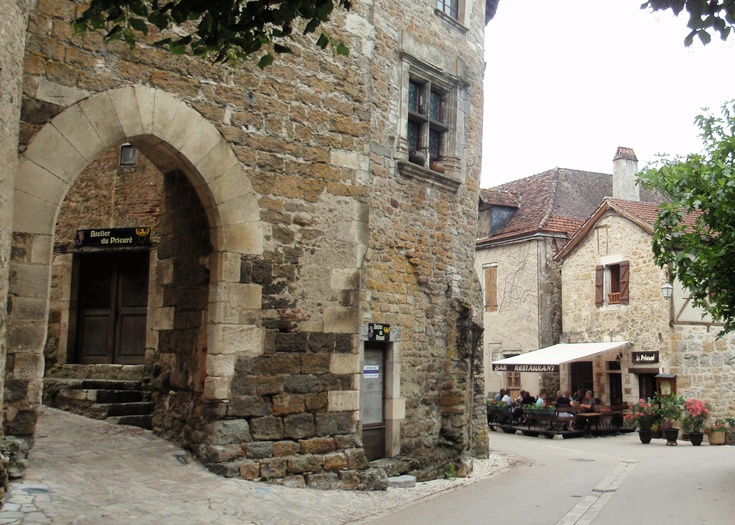
Carennac (Martel to Rocamadour)
Carennac
Founded in the eleventh century, Carennac grew around a monastery built here by Cluny monks. Today, the magnificent entrance to the church with its ornately carved twelfth-century tympanum is a focal point of the village. The adjoining cloister was added in the mid-1400s and is one of the most beautiful in France.
Carennac is located 100.2 kilometres (62.6 miles) along the Martel to Rocamadour walk and is my recommended stop on the eighth day of walking.
Take a closer look around Carennac and find a comprehensive list of accommodation and transport options.
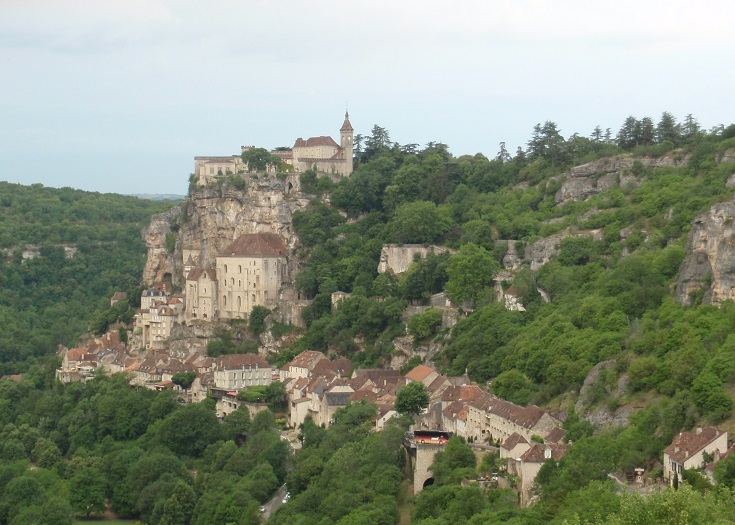
The view of Rocamadour from l’Hôpital (Martel to Rocamadour)
Rocamadour
Nine days of walking from Martel brings you to Rocamadour—an ancient village clinging precariously to the side of cliff, and the second most important religious site (after Mont-Saint-Michel) in France.
Until the middle of the twelfth century, Rocamadour was considered another stop on one of the minor pilgrim routes leading to Santiago de Compostela, but the discovery of a body—believed to be that of Zaccheus, servant of the Virgin Mary—beneath the steps of the chapel, elevated the status of the village significantly. During the day, the main street of Rocamadour may be filled with tourists, but food vendors, tradesmen and artisans have traded along this street since the first pilgrims arrived 1,000 years ago.
Take a closer look around Rocamadour and find a comprehensive list of accommodation and transport options.
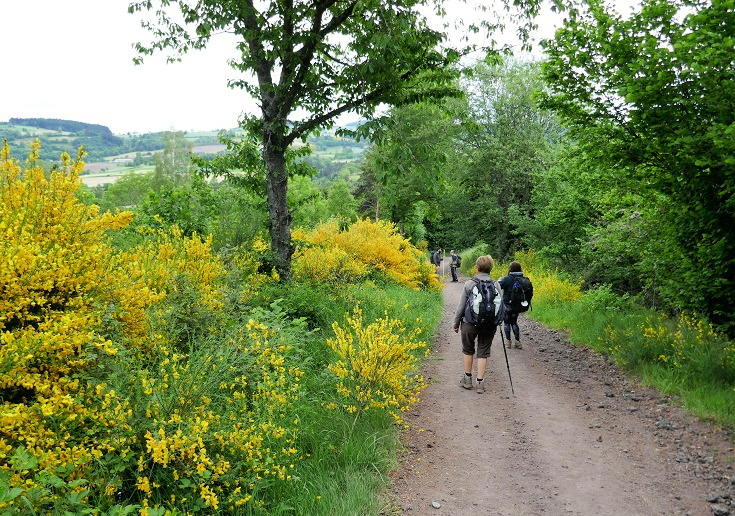
Somewhere between Le Chier and Saint-Privat-d’Allier (Chemin de Saint-Jacques du-Puy: Stage 1)
Most beautiful villages along the Chemin de Saint-Jacques du-Puy
The Chemin de Saint-Jacques du-Puy starts in Le Puy-en-Velay in the Haute-Loire region of France and winds its way over 750 kilometres (470 miles) south-west, passing through the Lozère, Lot, Tarn-et-Garonne, Gers and Landes regions, before reaching Saint-Jean-Pied-de-Port in the Pyrénées-Atlantiques. The most popular of the four pilgrim trails which traverse France, it was first walked in the tenth century by Bishop Gothescale.
Along the way, it passes through eleven of France’s ‘most beautiful villages’ including –
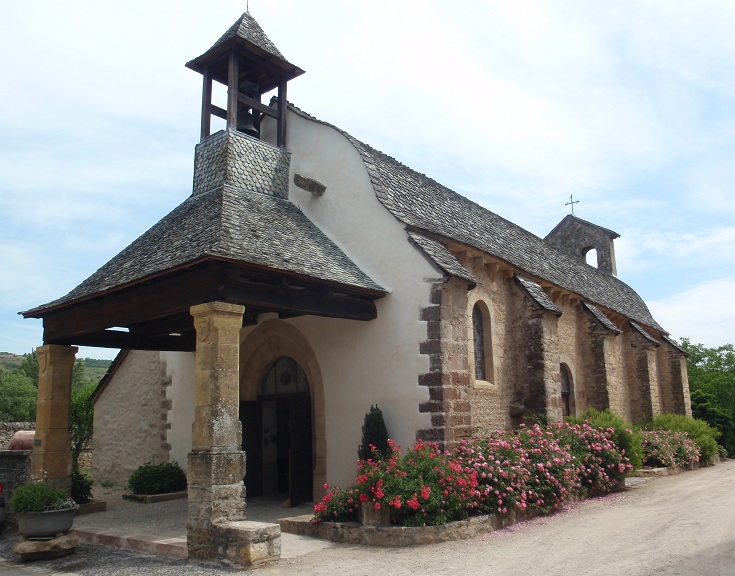
Saint-Côme-d’Olt (Chemin de Saint-Jacques du-Puy)
Saint-Côme-d’Olt (Stage 2: Aumont-Aubrac to Figeac)
Many of the highlights in Saint-Côme-d’Olt, including the Chapelle des Pénitents pictured above, are located a block or two away from the chemin and are easily missed if you simply follow the trail markers through the town. Particularly poignant since Covid-19 is the memorial at l’Ouradou which honours the more than 1,500 villagers (three-quarters of the population) who lost their lives when the plague swept through this region in 1586.
Saint-Côme-d’Olt is located 148 kilometres (92.5 miles) along the Chemin de Saint-Jacques du-Puy. If you are following my relaxed 42-day itinerary, you’ll arrive in time for lunch on the tenth day of walking. If you prefer a quicker pace, you’ll arrive in time for lunch on the seventh day of my 34-day itinerary.
Take a closer look around Saint-Côme-d’Olt and find a comprehensive list of accommodation and transport options.
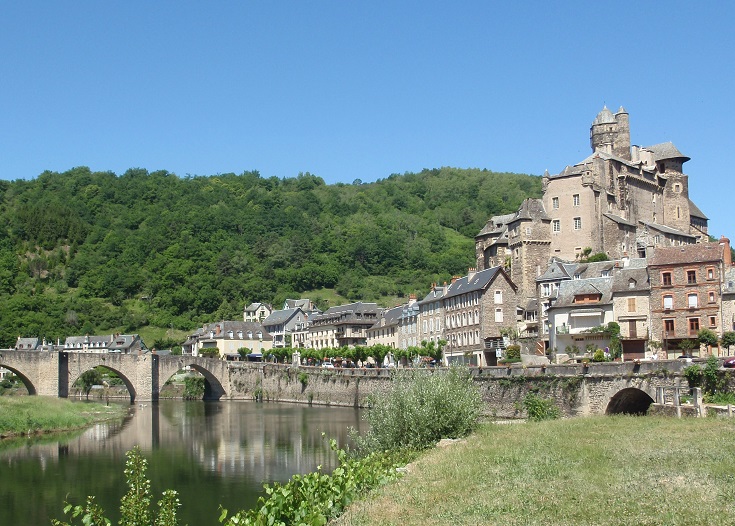
Estaing (Chemin de Saint-Jacques du-Puy)
Estaing (Stage 2: Aumont-Aubrac to Figeac)
A maze of impossibly pretty back streets and an imposing eleventh-century château, puts Estaing high on my list of favourite places to visit in France. It would be a great shame to rush past the village without taking a close look, so this day’s walk from Espalion is a short 12 kilometres (7.5 miles) – leaving you all afternoon to wander the streets and perhaps take a tour of the château.
Estaing is located 168 kilometres (105 miles) along the Chemin de Saint-Jacques du-Puy If you are following my relaxed 42-day itinerary, you’ll arrive at the end of the eleventh day of walking. If you prefer a quicker pace, you’ll arrive at the end of the eighth day of my 34-day itinerary.
Take a closer look around Estaing and find a comprehensive list of accommodation and transport options.
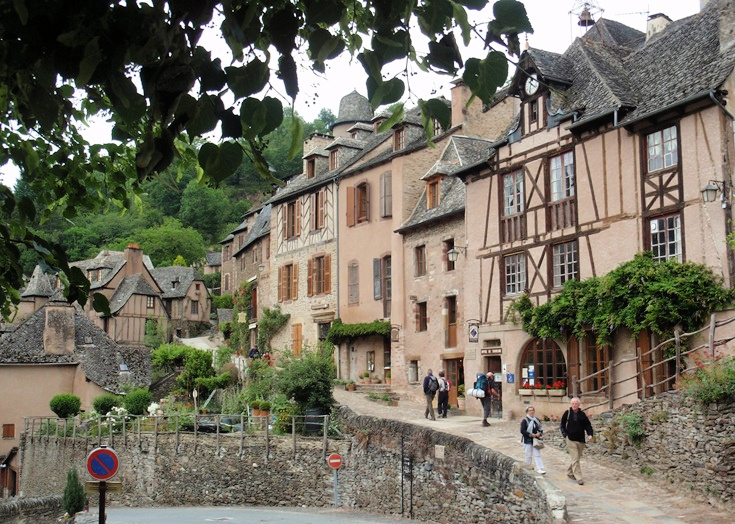
Conques (Chemin de Saint-Jacques du-Puy)
Conques (Stage 2: Aumont-Aubrac to Figeac)
In 303 AD in the nearby town of Agen, a thirteen year old girl (now Sainte) Foy, was beheaded when she repeatedly refused to deny her Christian faith. Five centuries later, Foy’s relics were ‘borrowed’ from the abbey and brought to Conques where a magnificent church was built in her honour. Ever since then, Conques has been an important stop on the pilgrimage to Santiago de Compostela and Vespers, held in the abbey each night, are a highlight for many walkers.
Conques is located 203.5 kilometres (127.2 miles) along the Chemin de Saint-Jacques du-Puy If you are following my relaxed 42-day itinerary, you’ll arrive at the end of the thirteenth day of walking. If you prefer a quicker pace, you’ll arrive at the end of the tenth day of my 34-day itinerary.
Take a closer look around Conques and find a comprehensive list of accommodation and transport options.
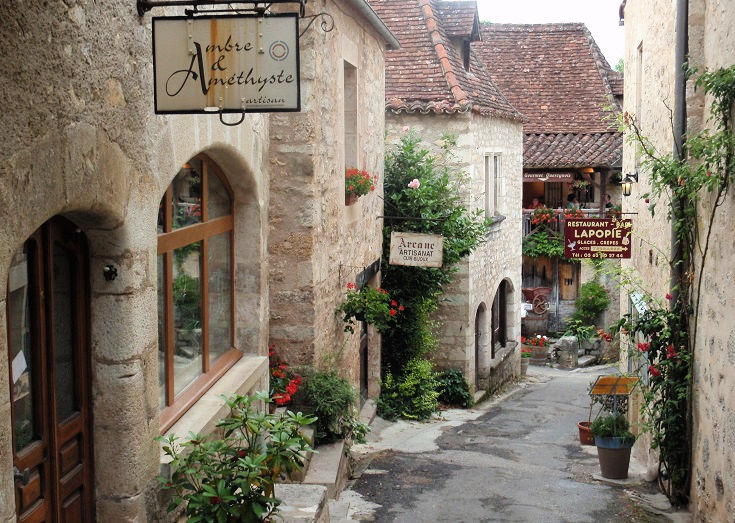
Saint-Cirq-Lapopie (Célé variante, Chemin de Saint-Jacques du-Puy)
Saint-Cirq-Lapopie (Stage 3: Figeac to Cahors)
Between Figeac and Cahors, walkers have a choice between two well-trodden paths – the traditional pilgrims’ route which follows the GR 65 path and the longer, more northerly route known as the Célé variante. Saint-Cirq-Lapopie, with its imposing sixteenth-century church and gorgeous medieval stone-and-timbered houses is one of the reasons I recommend taking the Célé variante . This is a village to be savoured and enjoyed slowly and if you have the time, now is the perfect time to take a rest day from walking and relax among the cafés and gift shops.
Saint-Cirq-Lapopie is located 320.8 kilometres (200.5 miles) along the Chemin de Saint-Jacques du-Puy on the Célé variante and is my recommended stop on the nineteenth day of walking.
Take a closer look around Saint-Cirq-Lapopie and find a comprehensive list of accommodation and transport options.
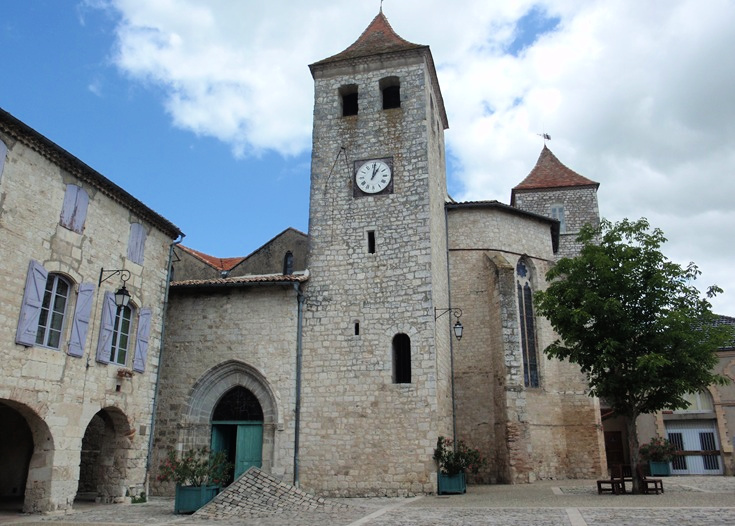
Lauzerte (Chemin de Saint-Jacques du-Puy)
Lauzerte (Stage 4: Cahors to Eauze)
Protected by towers and six gates controlling the entrance to the village, Lauzerte was the earliest version of the bastide, or fortified town, which provided a strategic defence post for noble rulers from the thirteenth century. Although most of the city walls and fortifications are long gone, the village oozes medieval charm and it is well worth allowing an hour or two to wander the streets and enjoy the views from Place du Château.
Lauzerte is located 386.8 kilometres (241.8 miles) along the Chemin de Saint-Jacques du-Puy If you are following my relaxed 42-day itinerary, you’ll arrive at the end of the twenty-third day of walking. If you prefer a quicker pace, you’ll arrive at the end of the eighteenth day of my 34-day itinerary.
Take a closer look around Lauzerte and find a comprehensive list of accommodation and transport options.
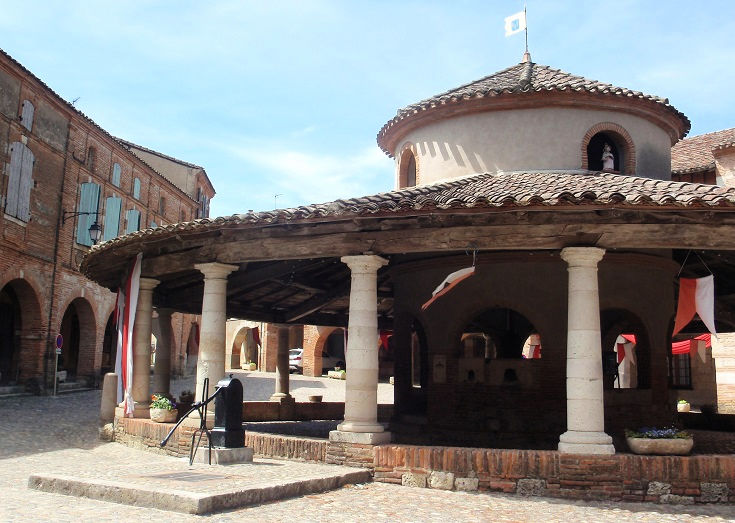
Auvillar (Chemin de Saint-Jacques du-Puy)
Auvillar (Stage 4: Cahors to Eauze)
First settled in Gallo-Roman times (100 BC—500 AD), Auvillar occupies a commanding position high on a ridge above the Garonne River. Despite this strategic advantage, the village suffered much damage during the Hundred Years War and the Wars of Religion in the fourteenth and sixteenth centuries. Today, Auvillar boasts many beautiful sights including the clock tower and the Halle Circulaire, all surrounded by a charming melange of red brick and timbered buildings.
Auvillar is located 434.8 kilometres (271.8 miles) along the Chemin de Saint-Jacques du-Puy If you are following my relaxed 42-day itinerary, you’ll arrive at the end of the twenty-sixth day of walking. If you prefer a quicker pace, you’ll arrive at the end of the twentieth day of my 34-day itinerary.
Take a closer look around Auvillar and find a comprehensive list of accommodation and transport options.
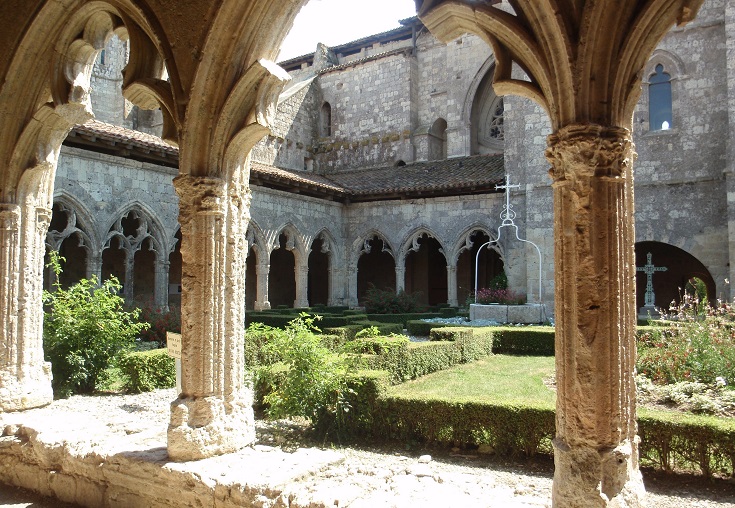
La Romieu (Chemin de Saint-Jacques du-Puy)
La Romieu (Stage 4: Cahors to Eauze)
Founded in the eleventh century by two monks returning from a pilgrimage to Rome, the village of La Romieu has a long and checkered past. The collegiate church was built in 1318, with the cloister and Cardinal’s Palace added soon after. In 1790 during the French Revolution, the original church built by the two monks was destroyed and the collegiate church (which stands today) was demoted to a parish church. A climb to the top of the Belvedere Tower offers spectacular views over the surrounding countryside.
La Romieu is located 486.1 kilometres (303.8 miles) along the Chemin de Saint-Jacques du-Puy If you are following my relaxed 42-day itinerary, you’ll arrive at the end of the twenty-ninth day of walking. If you prefer a quicker pace, you’ll arrive in time for lunch on the twenty-third day of my 34-day itinerary.
Take a closer look around La Romieu and find a comprehensive list of accommodation and transport options.
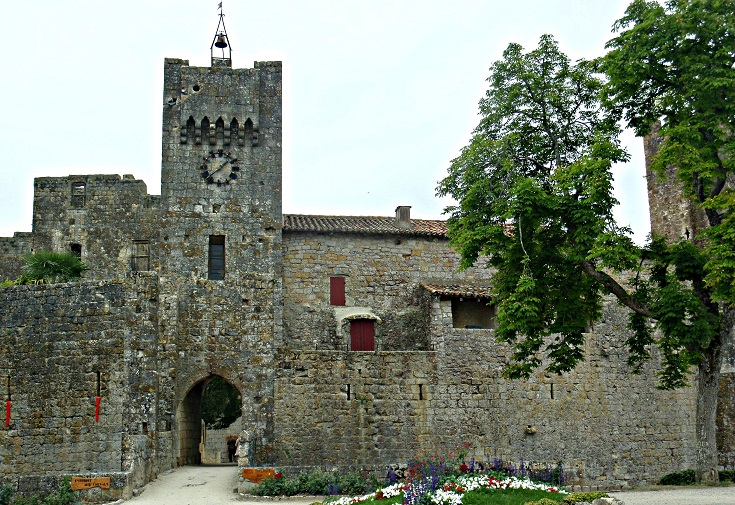
Larressingle (Chemin de Saint-Jacques du-Puy)
Larressingle (Stage 4: Cahors to Eauze)
Located a fifteen-minute walk from the Chemin de Saint-Jacques, the village of Larressingle is a stunning example of a thirteenth century fortified village with high stone walls and a dry moat, enclosing a château, church and the houses of the clergy and villagers. Built in the thirteenth century for the Bishops of nearby Condom, the village fortress survived the Hundred Years War and the Wars of Religion. Enjoy an early lunch and head into any of the gift shops for a glimpse inside the walls.
Larressingle is located 504.1 kilometres (315.1 miles) along the Chemin de Saint-Jacques du-Puy. If you are following my relaxed 42-day itinerary, you’ll arrive mid-morning on the thirty-first day of walking. If you prefer a quicker pace, you’ll arrive mid-morning on the twenty-fourth day of my 34-day itinerary.

Montréal-du-Gers (Chemin de Saint-Jacques du-Puy)
Montréal (Stage 4: Cahors to Eauze)
Founded in 1255, Montréal was the first of the bastides, or fortified villages, built in the Gers region of France. Today, Montréal offers walkers easy access to all modern services in a setting of ancient arcades, imposing ramparts and quaint back streets.
Montréal is located 516 kilometres (327 miles) along the Chemin de Saint-Jacques du-Puy If you are following my relaxed 42-day itinerary, you’ll arrive at the end of the thirty-first day of walking. If you prefer a quicker pace, you’ll arrive at the end of the twenty-fourth day of my 34-day itinerary.

Navarrenx (Chemin de Saint-Jacques du-Puy)
Navarrenx (Stage 5: Eauze to Saint-Jean-Pied-de-Port)
Like many towns in southern France, Navarrenx was already well-settled when the Roman invasion swept through in the first century AD. The town’s long and often violent history is on display today in the imposing ramparts and three-metre-thick walls of the city gate. In 1569 during the Wars of Religion, Navarrenx held firm, surviving a siege lasting four months.
Navarrenx is located 674.8 kilometres (421.8 miles) along the Chemin de Saint-Jacques du-Puy If you are following my relaxed 42-day itinerary, you’ll arrive at the end of the thirty-ninth day of walking. If you prefer a quicker pace, you’ll arrive at the end of the thirty-first day of my 34-day itinerary.

Saint-Jean-Pied-de-Port (Chemin de Saint-Jacques du-Puy)
Saint-Jean-Pied-de-Port (Stage 5: Eauze to Saint-Jean-Pied-de-Port)
If a long-distance walk has to end, there can be no more beautiful place to complete your journey than Saint-Jean-Pied-de-Port. From the impossibly pretty Rue de la Citadelle, lined with chambre d’hôtes and gift shops, to the magnificent views from Chemin de Monde (which may just convince you to keep marching across Spain to Santiago de Compostela), Saint-Jean-Pied-de-Port is the perfect end to an epic walk! Take your time to savour the moment and soak up the magical delights of the village.
Saint-Jean-Pied-de-Port is located 740 kilometres (463 miles) along the Chemin de Saint-Jacques du-Puy (Following the Célé variante which passes through Saint-Cirq-Lapopie will increase the total distance walked to 760 kilometres (476 miles.)
If you are following my relaxed itinerary, you’ll arrive at the end of the forty-second day of walking. If you prefer a quicker pace, you’ll arrive at the end of the thirty-fourth day.
Take a closer look around Saint-Jean-Pied-de-Port and find a comprehensive list of accommodation and transport options.
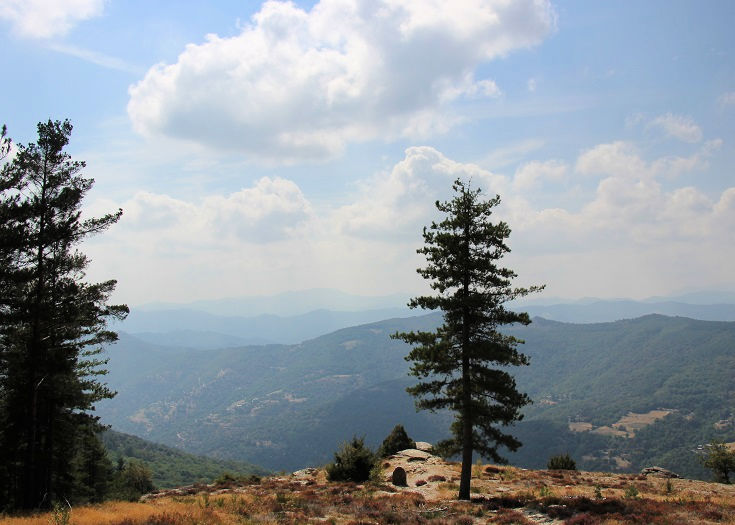
The Chemin de Stevenson passes through the Cévennes National Park
Most beautiful villages along the GR 70 Chemin de Stevenson
Best known for its rugged landscapes and endless hills, the Chemin de Stevenson follows a path first taken in 1878 by Scottish author Robert Louis Stevenson and his donkey Modestine. As he travelled south from Le Puy-en-Velay, through the Cévennes National Park to Saint-Jean-du-Gard, Stevenson recorded his journey in a small book Travels with a Donkey. Since then, thousands of walkers have followed in his footsteps.

Pradelles (Chemin de Stevenson)
Pradelles
The picturesque village of Pradelles is a highlight of the walk along the Chemin de Stevenson although it rated barely a mention in the author’s journal. He stopped for lunch at an inn on the way into town, then packed up and hurried on to spend the night in the forest beyond Langogne. Not a lot appears to have changed in the 150 years since Stevenson passed through. The narrow lanes flanked by ancient stone houses ooze with history—it’s easy to imagine guards stationed at the village gates, ready to lower the metal grills at the first signs of danger.
Pradelles is located 64.4 kilometres (40.3 miles) along the Chemin de Stevenson and is my recommended stop on the third day of walking.
Take a closer look around Pradelles and find a comprehensive list of accommodation and transport options.
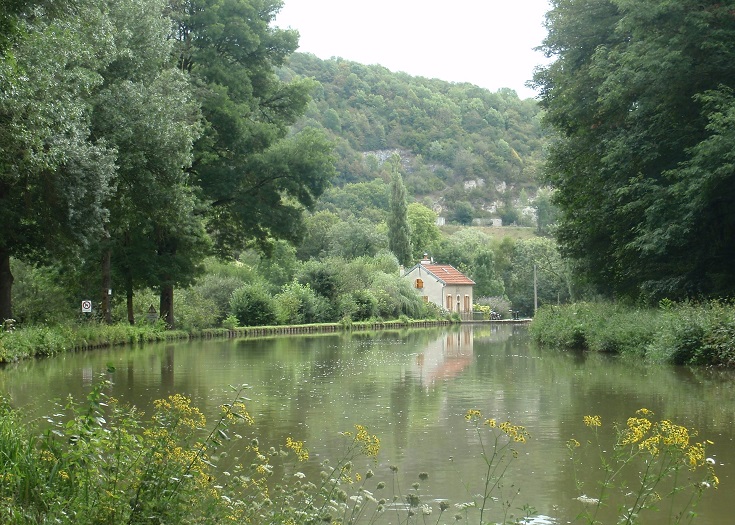
The Burgundy Canal between Crugey and Veuvey-sur-Ouche
Most beautiful villages along the Burgundy Canal
If your preference is for a flat and easy walk, then the Burgundy Canal is hard to beat. For most of its 240 kilometres (150 miles), the canal is a meandering ribbon of tranquil green water, winding through picturesque countryside and charming villages. Within easy walking distance or a short ride from the canal, seven châteaux, eleven churches and one abbey provide constant distraction ensuring you are never bored. My suggested itinerary recommends a mix of walking and cycling to complete the journey in twelve days, which includes two rest days to sight-see away from the canal.
The two ‘most beautiful villages’ are located a short distance from the canal but well worth a detour for a closer inspection.
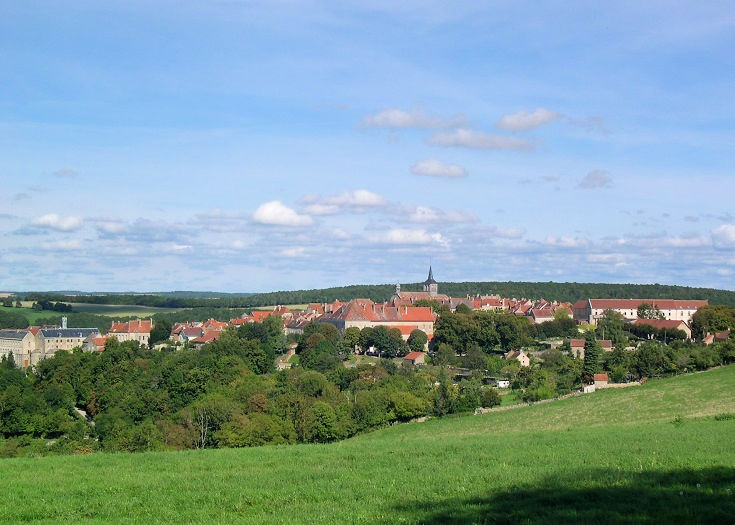
Flavigny-sur-Ozerain (Burgundy Canal)
Flavigny-sur-Ozerain (Stage 1: Migennes to Pouilly-en-Auxois)
Perhaps best known as the setting for the film Chocolat starring Juliet Binoche and Johnny Depp, Flavigny-sur-Ozerain is one of the loveliest of France’s ‘most beautiful villages’. As you wander the streets, you’ll pass the chocolate shop and the church of Saint-Genest – both instantly recognisable from the film. In real life though, Flavigny-sur-Ozerain is famous for its aniseed lollies and a visit to the lolly shop or the abbey where the lollies are made is a must-do (of course)!
Flavigny-sur-Ozerain is easily reached on bicycle from Venarey-les-Laumes which is located 114 kilometres (71 miles) along the Burgundy Canal and is my recommended stop on the sixth day of walking.
Take a closer look around Flavigny-sur-Ozerain and find a comprehensive list of accommodation and transport options.
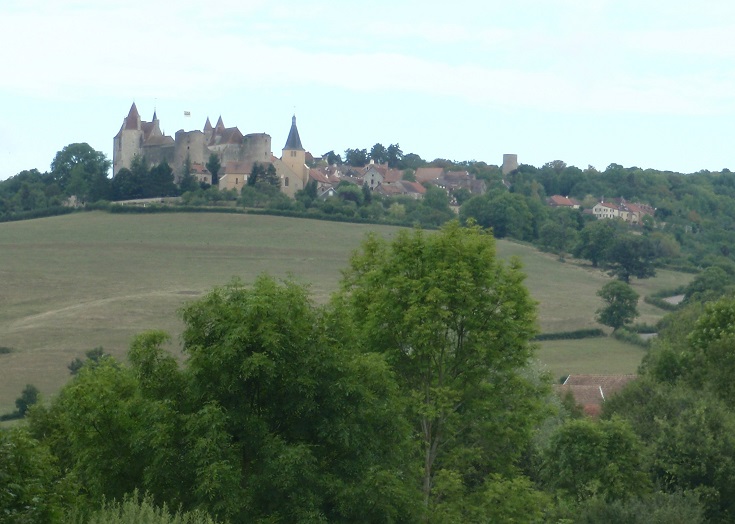
Châteauneuf-en-Auxois (Burgundy Canal)
Châteauneuf-en-Auxois (Stage 2: Pouilly-en-Auxois to Saint-Jean-de-Losne)
Visible for several kilometres from the canal, the towers and turrets of Châteauneuf-en-Auxois perched high on the hill are too intriguing to walk past. Built in the twelfth century, the château stayed in the same family for nine generations until 1456 when the last heiress, Cathérine de Châteauneuf, was burned alive as punishment for poisoning her second husband. Over the next 450 years, the château changed hands several times before it was donated to the state in 1936. On the far side of the village near the carpark, a lookout provides magnificent views down towards the canal and out to the cultivated fields and vineyards beyond.
Châteauneuf-en-Auxois is located 165 kilometres (104 miles) along the Burgundy Canal and is my recommended stop on the eighth day of walking.
Take a closer look around Châteauneuf-en-Auxois and find a comprehensive list of accommodation and transport options.
FAST FACTS
You’ll find a list of all ‘most beautiful villages’ in France on the association’s official website.
You’ll find a comprehensive list of places offering overnight accommodation at the links throughout this post (no weekly rentals included).
How to book accommodation in French
Practical tips for long-distance walking—preparation, packing and avoiding blisters

